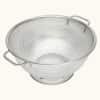Turning Bread into Boules
A colander, with a little help, can serve as an improvised banneton for proofing bread dough.
French bakers achieve the symmetrical round loaves of bread known as boules by transferring the dough to shallow, linen-lined woven baskets known as bannetons or brotforms for the last rising step before baking. The cloth-lined basket serves two functions: It retains the round shape of the loaf as it proofs, and its breathable construction wicks away moisture from the dough’s surface, for a crisper, browner crust. While an ordinary bowl isn’t a suitable substitute, you can still create an improvised banneton at home: Line a metal or plastic colander with a linen dish towel (linen is preferable to cotton, since cotton has microscopic fibers that can stick to dough) and dust it liberally with flour. Place the formed loaf upside down in the colander, fold the cloth loosely over it, and place the colander (which allows in more air than a true banneton) in a loose plastic bag to protect the dough from drafts. The method will produce a beautifully shaped boule that would be impossible to replicate if you simply left the dough to proof on its own.
AUTHENTIC BANNETON: This French basket retains the round shape of a loaf during proofing.
OUR FACSIMILE: A dish towel and a colander work just fine as a stand-in for the real thing.


